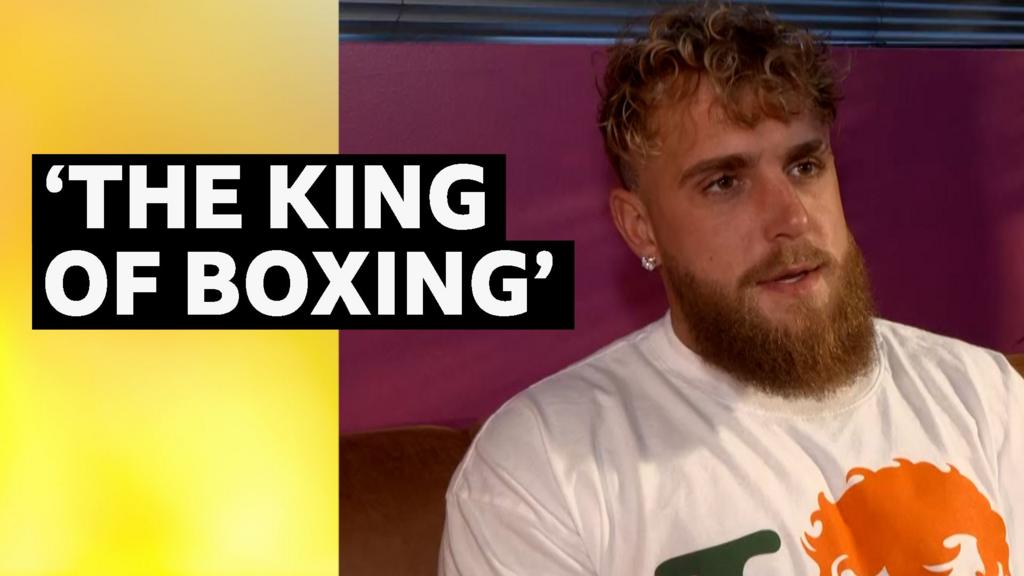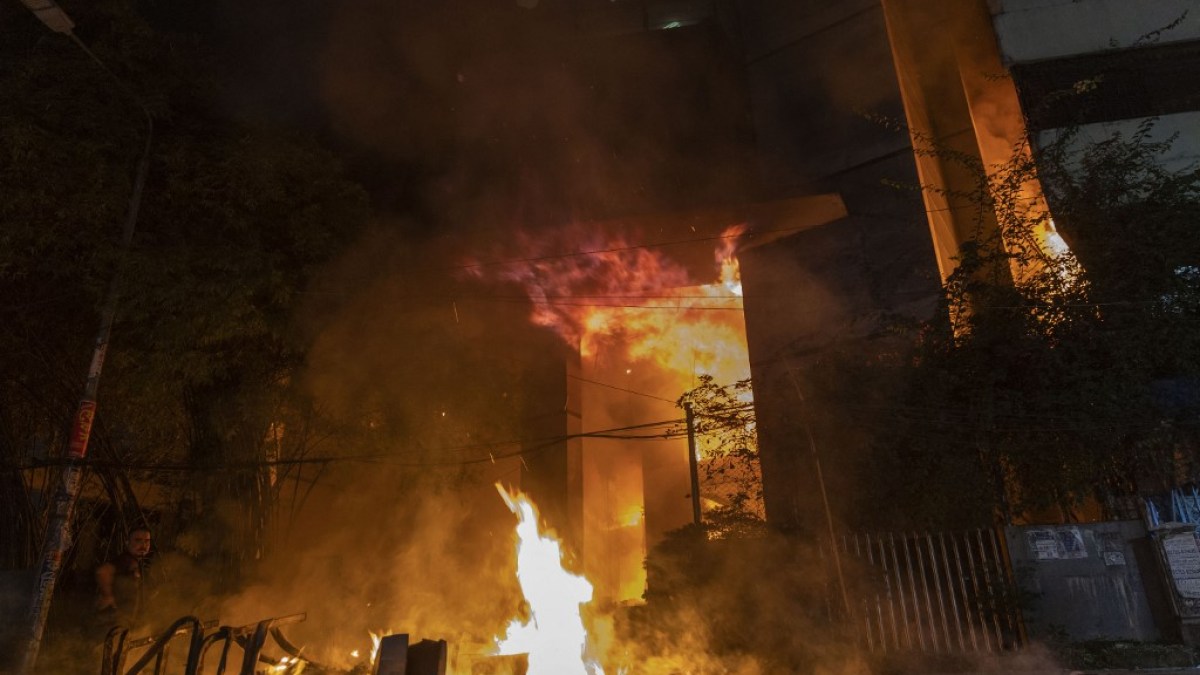When he defeats Anthony Joshua on Friday night in Miami, Joe Paul promises to “turn the boxing world upside down.”
Joshua presses Paul’s fist away in “Don’t touch me.” READ MORE:


With the birth of his girlfriend Elsie Hewitt, Pete Davidson is now a father. Elsie gave her name and shared images of the couple’s bundle of joy.
On Thursday (18 December), the model shared the news on Instagram. She shared a photo of herself and comedian Pete kissing their daughter’s face, which was obscured by a white heart emoji and wearing matching baggy black outfits.
**This is a significant piece of showbiz news. Join The Mirror’s ****WhatsApp Community ****or follow us on **Google News**, **Flipboard**, Apple News, **TikTok**, **Snapchat**, **Instagram**, **Twitter**, **Facebook**, **YouTube** and **Threads** – or visit The Mirror homepage**.

Third Ashes Test, Adelaide Oval (day two of five)
Australia 371: Carey 106, Archer 5-53 & 271-4: Head 142*, Carey 52*
England 286: Stokes 83, Archer 51; Boland 3-45
Australia lead by 356 runs
England were pushed towards the precipice of the fastest Ashes series defeat in more than 100 years as a Travis Head century maintained Australia’s grip on the third Test in Adelaide.
Head was dropped on 99 by Harry Brook and spent eight balls one run short of a hundred before belting Joe Root down the ground for four to draw a deafening roar from his home-town crowd at the Adelaide Oval.
The left-hander moved Australia’s second innings to 271-4 and their overall lead to 356 at the end of the third day.
If England’s third loss in as many Tests is completed on Saturday, it would mean the Ashes have been decided in 10 days of cricket.
Not since 1921, when Australia needed only eight days of play to win in England, has the destination of the urn been settled so swiftly.
Head’s inevitable ton snuffed out brief England hope that was raised when captain Ben Stokes and Jofra Archer added 73 runs in the morning session.
Stokes made 83 and Archer 51 in a stand of 106, the highest by an England ninth-wicket pair in Australia since 1924.
By creeping to 286 all out, 85 behind on first innings, England could have left themselves an outside chance by dismissing Australia for a total below 240 in their second innings.
At 53-2 and 149-4, England clung on before being cut adrift by Head. At some point, England will be tasked with pulling off the highest successful chase on this ground in order to keep the Ashes alive.
Realistically, England’s fate in this match and the series was sealed by their batting on the second day.
It needed a trademark Stokes miracle to keep his team from their destiny and, despite how well the captain and Archer have personally performed in this match, Stokes might have exhausted his escape acts.
There will be questions over all-rounder Stokes’ physical state for the rest of the series. Never one to avoid work when his team need him, there were times when he was bent double in the field.
Bar the 90 minutes of resistance England mustered in the morning session, this day went as expected – Australia batting under minimal pressure, grinding England into the dirt.
England’s effort cannot be faulted, they are simply being outclassed. They are suffering a slow death in the City of Churches, a prolonged post-mortem of the Bazball project.
Head’s elevation to open the batting on the second day of the first Test will go down as one of the defining moments of the series. His match-winning century in Perth gave Australia a momentum they have never looked like relinquishing.
This ton was memorable for different reasons. Like Alex Carey on day one, Head is another South Australian enjoying an Ashes moment on home turf. This was his fourth successive century in Tests at the Adelaide Oval.
He had to endure a lively England burst with the new ball, particularly from Brydon Carse. With the storm weathered, Stokes absent from the attack and Will Jacks unable to hold an end, Head cashed in.
England tried different plans, at one point packing the off side with seven fielders, but Head still found ways to score. He added 84 for the fourth wicket with Usman Khawaja, who made 40 to further his case to be retained for the fourth Test.
The chance to Brook, off the bowling off Archer, was a powerful slash to gully. It would have been a smart catch, though should have been taken. In the next over, Head lofted Root’s off-spin down the ground to complete his 11th Test ton.
Stokes and Archer are among the few England players to have performed so far on this tour. Their tight relationship goes back to the 2019 World Cup final.
When Stokes was captured on camera on the second morning giving Archer a tounge-lashing for his bowling, it was an example of how Stokes knows he can get the best from his paceman.
From 213-8 overnight, and with 12 overs in the morning before the second new ball, the ninth-wicket pair were more expansive than the previous evening.
Stokes drove Scott Boland for four from the third ball of the day, Archer swiped Nathan Lyon over long-on for six.
Stokes’ 50, from 159 balls, was his slowest in Test cricket and the slowest by any England batter in the Bazball era. Archer, who took five wickets in Australia’s first innings, made his maiden half-century in Tests and the second-highest score by an England number 10 in Australia.
Stokes deserved a hundred only for Mitchell Starc to hit the stumps through the gate. Stokes roared in frustration, while Archer chased the captain all the way to the boundary to pat him on the back.



Early on Friday, European Union leaders made a decision not to use frozen Russian assets to support Ukraine’s defense of the country’s ongoing conflict with Russia.
Instead, 23 of the 27 EU member states will offer an interest-free loan worth 90 billion euros ($106bn). Following months of deliberation and tense discussions on Thursday night, Hungary, Slovakia, and the Czech Republic each received an exemption to pass the deal.
If Ukraine wants to avoid bankruptcy as soon as April, the European Commission has proposed a plan to use some of the bloc’s frozen Russian central bank assets. This is estimated to cost the country an additional 136 billion euros ($159 billion) over the next two years.
However, Belgian Prime Minister Bart De Wever had declined to agree to this without giving “ironclad guarantees” that Belgium, where the majority of the country’s assets are located, would be shielded from potential Russian legal retaliation.
If Moscow successfully files a lawsuit against Euroclear, a provider of financial market infrastructure (FMI) in the Eurozone, where the funds are held, Belgium estimated that it might be left owing billions of euros.
Hungary’s prime minister Viktor Orban referred to the plan as “the dead end,” while Slovakia and Hungary had also voiced strong opposition to it.
Vladimir Putin, the president of Russia, has claimed that using frozen assets to finance Ukraine would be theft-like.
In order to provide Ukraine with an initial 90-billion-euro ($106bn) loan, the EU would have borrowed from Euroclear, a Belgian-based clearing house with assets worth more than 40 trillion euros ($47 trillion). Up until 2027, this will cover roughly two-thirds of Ukraine’s funding needs.
If Russia had agreed to pay Ukraine’s veterans for the war, the loan would only have needed to be paid back. According to the European Parliament, reconstruction costs from the war are estimated to be worth about $524 billion.
Since the Ukrainian invasion of 2022, more than 289.5 billion euros (339.3 billion) of Russian assets have been frozen by Western nations, with the EU holding 209 billion euros (247 billion) of these. The largest share, 180 billion euros ($210 billion), is held by Belgium.
Numerous EU members, besides Belgium, are against the plan, with Belgium voicing concern that using frozen assets without solid EU guarantees is “fundamentally wrong.”
It warned that Russia could target Belgian property in Russia in response, and that other Russia-friendly nations could file legal claims against Euroclear as well.
Viktor Orban, the prime minister of Hungary, said that obtaining Russian assets would increase the conflict in Ukraine.
The European Union would like to take the money from one of the warring parties and then give it to another one, he said to reporters, “There are two countries that are at war. It’s not the European Union, it’s Russia and Ukraine.”
It is “marging into the war,” it says. We should not do that, the Belgian prime minister said.
While Russia is the most well-known non-European nation with significant assets that have been frozen in Europe, several other nations outside of Europe are also subject to asset freezes as a result of the EU sanctions.
Most other countries on this list have mostly government-related assets, oligarchs, or specific state-owned companies frozen, compared to their entire national reserves, despite the EU’s unique situation, which has caused Russia’s situation.
The EU has placed asset freezes and a ban on making money available in at least 31 nations, according to the sanctions tracker from the European Commission. Other asset freezes occur directly as a result of EU decisions, including those regarding Venezuela, while many of the moves are mandated by the UN and then put into place by the EU.
Find out which other nations’ assets have the EU frozen, by looking at the table below.
In response to Venezuela’s demise of democratic rule and human rights abuses under President Nicolas Maduro, the EU frozen the assets of Venezuelan entities and individuals in 2017. The European Council only recently extended these measures until January 2027, specifically to those who committed serious violations.
The European Council imposed sanctions on Syria in 2013 including asset freezes and financial restrictions. Member states are prohibited from making any new commitments to the Syrian government, including grants, financial aid, or concessional loans.
These measures were in place to protest human rights violations committed under Bashar al-Assad’s regime, which was finally overthrown in December of last year. Any individuals or organizations that supported the regime and the production of chemical weapons were included in the measures expanded in 2014 as well.
The EU continued to freeze the Assad regime and the drug trade after the government was overthrown in December 2024, but it suspended some of these measures to support the political transition in Syria.
The United Kingdom has frozen the assets of individuals and entities from 22 nations, with the majority of them being EU-sanctioned, according to the Office of Financial Sanctions Implementation (OFSI), which monitors financial sanctions.
Typically, assets are frozen using the Specially Designated Nationals (SDN) List. The US has almost completely frozen the assets of four nations, including Cuba, Iran, North Korea, and Russia, according to the Treasury’s Office of Foreign Assets Control (OFAC), which lists various sanctions levels. US President Donald Trump lifted US sanctions against Syria in an executive order issued in June of this year.


After protests turned violent late on Thursday, police and paramilitary units increased patrols in Dhaka, aiming specifically at political buildings, media buildings, and cultural institutions. Residents reported high tensions, especially before Friday morning prayers, even though the streets were largely calm on Friday morning.
list of 3 itemsend of list
The unrest came after Sharif Osman Hadi, a 32-year-old spokesperson for Platform for Revolution, passed away. As Hadi launched his campaign last Friday in Dhaka, he was shot in the head by masked attackers.
He was flown to Singapore for advanced care, where he passed away after six days on life support, first at a nearby hospital.
Hadi was a key figure in the student-led uprising that forced Prime Minister Sheikh Hasina to flee the nation last year. Hadi was also known for his outspoken criticism of India, while Inquilab Mancha describes itself as a “revolutionary cultural platform inspired by the spirit of uprising.”
Protesters detained the English-language Daily Star and Prothom Alo, Bangladesh’s largest daily newspaper, on Thursday night. Later, firefighters extinguished the blaze at The Daily Star while ensuring security for journalists trapped inside.
Protesters chanted slogans praising Hadi’s name, promising to keep the demonstrations going, and pleading for swift justice. As more force was used by authorities to avert further violence, several neighborhoods continued to be tense.
Since August 2024, when Hasina, a long-time leader, fled to India after a mass protests, the interim administration has been in place there under the leadership of Nobel Peace Prize laureate Muhammad Yunus.
Hasina’s Awami League is prohibited from participating in the February 12 election, and the government is under increasing pressure for delayed reforms.
In a televised address after Hadi’s passing, Yunus stated that the country’s political and democratic spheres were irreplaceable. He urged calm, urged transparency in the investigation, and warned that violence could threaten the vote’s legitimacy.
The interim administration held special prayers throughout the country and a day of state mourning on Saturday.
Sheikh Mujibur Rahman, Bangladesh’s first president and Hasina’s murdered father, was also targeted twice last year by protesters who tore through his home. Awami League offices were bulldozed in Rajshahi, and several districts’ highways were blocked.
Anti-India sentiment has grown since Hasina’s flight to New Delhi, and violence has also spread to Chittagong, where protesters have attacked the Indian Assistant High Commission.
Hasina was sentenced to death in November by hanging and then guilty of crimes against humanity for ordering a bloody siege against a student-led uprising that ended up killing her.
After weeks of student-led protests against her “autocratic rule,” Hasina fled Bangladesh on August 5, 2024 by helicopter.
Sajjat Hosen Sojal, the mother of 20-year-old student Sajjat Hosen, was shot and burned by the police shortly before Hasina was forced to resign and flee the country, according to Shaina Begum, who told Al Jazeera after the verdict: “I cannot be calm until she is brought back and hanged in this country.”